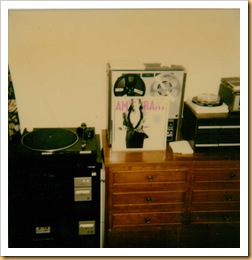An archive Aircheck recording from 1984 is below today’s post.
Since 1984 or a few months prior, I have recorded radio shows off the air for later listening—much like VCR’s and now DVR’s have been used to record television. Becoming a disk jockey at age 17 gave me the luxury of recording my own shows directly from the broadcast soundboard (most jocks called it “the board,” for short.) This method preserved the best quality sound before extra circuitry and processing were added to the signal.
 My experience going into broadcasting involved my dad’s tutelage on his Dokorder ¼” reel-to-reel and other tape decks in his collection; including countless live sessions recorded on them in churches where he would sing and preach. In addition, I had educated myself by devouring Stereo Review and Audio magazines succumbing to their admittedly stuffy technical style regarding sound and its associated high-end gear and snobby classical music reviews. Despite all that, my subscriptions lasted well into the next decade.
My experience going into broadcasting involved my dad’s tutelage on his Dokorder ¼” reel-to-reel and other tape decks in his collection; including countless live sessions recorded on them in churches where he would sing and preach. In addition, I had educated myself by devouring Stereo Review and Audio magazines succumbing to their admittedly stuffy technical style regarding sound and its associated high-end gear and snobby classical music reviews. Despite all that, my subscriptions lasted well into the next decade.
My Gospel music shows were not stereophonic because the AM control room board was wired for monaural only (the turntables were stereo). It was my assumption that in those days AM station owners saw no need to install stereo mixers in their control rooms. That was, until my second radio home blew me away with its election to go full stereo although we were still broadcasted in mono.
Anyway, I recorded my own afternoon DJ shows on the station’s ReVox A-77 ½ track professional stereo deck on a recycled 1200’ reel of tape. At 7½ i.p.s. this yielded about 30 minutes of record time. I taped the last half hour each day. Bringing home the 7” reel each night, I played back the tape on dad’s Dokorder (a consumer ¼ track tape deck.) The two tape decks were slightly incompatible due to the wider track configuration of the professional unit at work. With some electronic tinkering, I made decent playback at home (thanks to a Radio Shack y-adapter.) From there I would edit out commercials and music onto either my Pioneer CT-330 cassette deck or dad’s more preferable Yamaha TC-511S. The “pause” button got a real workout. The final “scoped” airchecks laid neatly in chronological order onto a BASF Chrome Cassette. These early recordings were an invaluable teaching aide, my close companion, in improving my on-air delivery into the following years.
I found this method cumbersome and discontinued recording soundboard direct on reel. As an alternative, I would borrow the Yamaha from home until a decent cassette recorder was installed in the studio. I accepted the audio quality tradeoff, switched to cassette and seldom looked back. Not wanting to edit on the fly, almost all of my airchecks were unscoped (see the Aircheck Glossary) thereafter. I felt an extra generation of tape in the cassette realm was too much of an audio compromise. Listen below or download here.
Stay tuned.
The photos top left and to the right are of my Pioneer rack system in 1984 with the Dokorder on the chest. A ReVox A-77 is pictured in the middle. Below is a Yamaha like dad’s.

No comments:
Post a Comment